Language Translation Services RFP and Government Bids
Win more government contracts with the right language translation services RFP; see what to include, avoid, and demand before you bid.
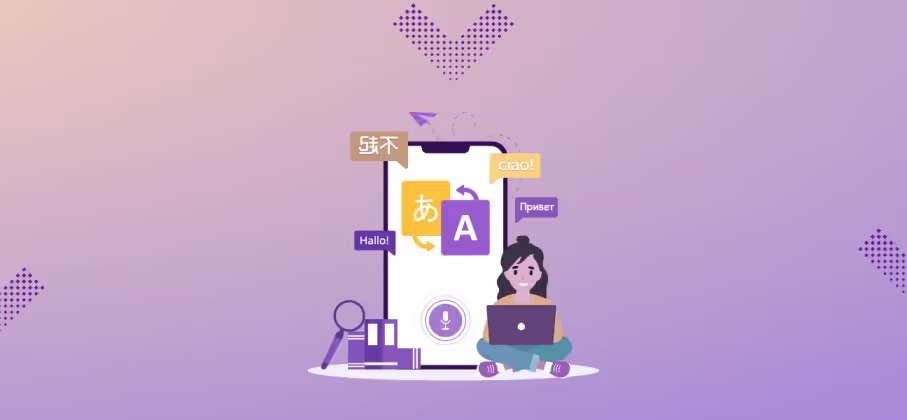
Winning government contracts is not easy. If you're a language service provider, you already know how much pressure comes with responding to an RFP. Tight deadlines, strict formatting, and no room for error.
You’re juggling team bandwidth, accurate translations, and compliance documentation while also trying to stay competitive on pricing. It can feel overwhelming, especially if you’ve lost bids in the past without clear feedback.
Government agencies depend on multilingual communication across healthcare, legal, and emergency services. A strong language translation services RFP response is not just about showcasing your capabilities. It is about proving you can help them serve diverse populations reliably.
Here’s the reality. In 2025, over 87% of LSPs still use outdated pricing structures that confuse procurement teams. When clarity is critical, this alone can cost you the deal.
This guide is built for you, the translation professional who wants to get it right and win more bids. It covers what government buyers expect in your proposal, what to avoid, and how to stand out.
Key Takeaways
- Government translation RFPs require precise alignment with agency goals, strict adherence to formatting rules, and clear demonstration of language and subject-matter expertise.
- Understanding legal mandates like federal language access requirements is essential for vendors to meet compliance and secure contracts.
- Strong proposals highlight detailed translation workflows, security measures, and up-to-date credentials to build trust and credibility.
- Avoid common pitfalls like generic content reuse and outdated documentation, which often lead to bid disqualification.
- Tailored, well-structured responses that emphasize transparency and collaboration increase the chances of winning government translation contracts.
What Is a Language Translation Services RFP?
A Language Translation Services RFP is a formal document issued by government agencies to invite qualified translation vendors to submit proposals. These RFPs specify requirements, deadlines, and evaluation criteria for translation projects covering multiple languages and formats.
Government agencies use these RFPs to ensure accurate, compliant, and accessible multilingual communication in critical public services. Vendors must carefully respond to complex scopes, technical terminology, and regulatory standards to have a chance at winning contracts.
Typical Use Cases for Government-Issued Translation RFPs
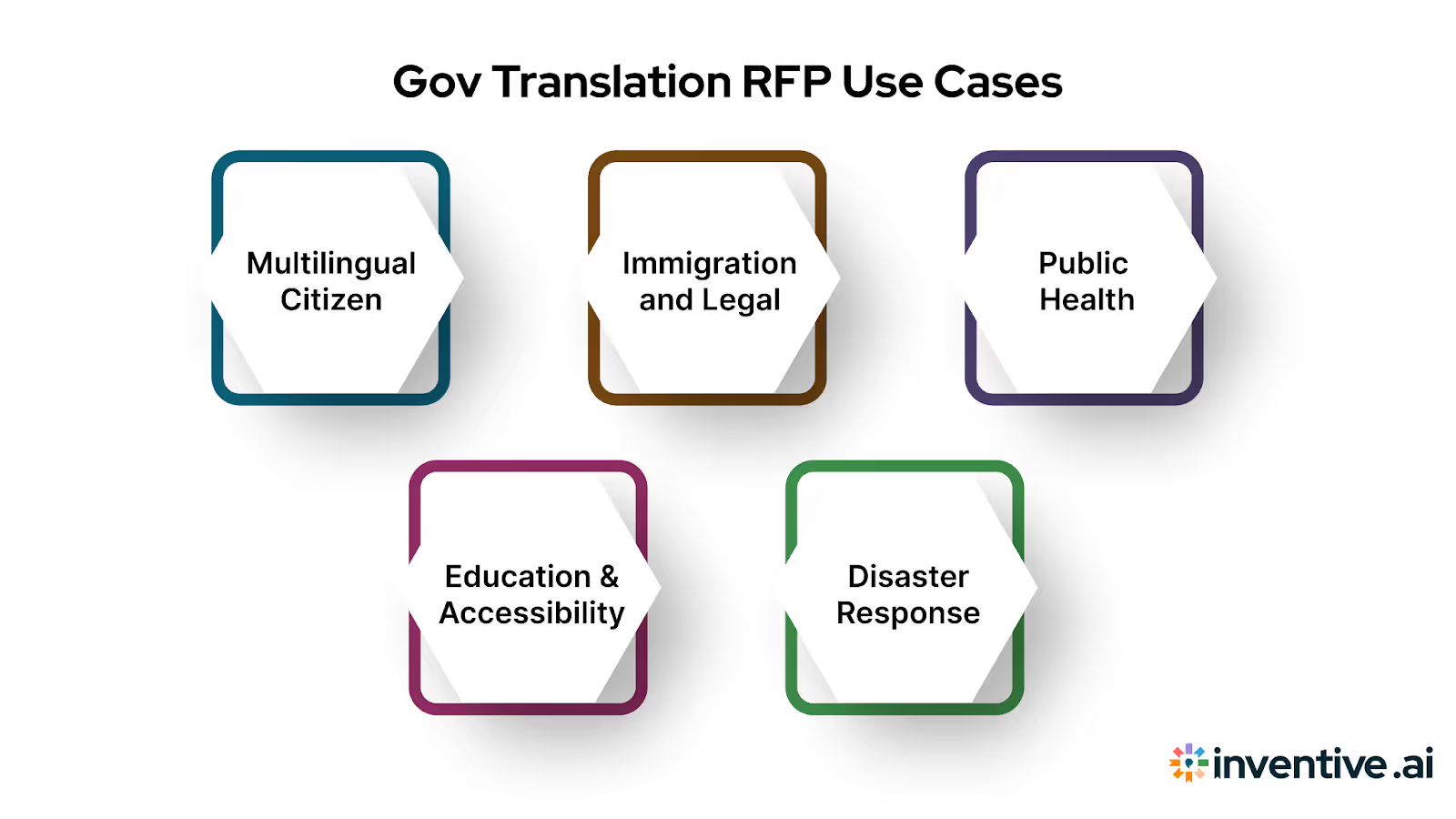
Language translation RFPs are issued to support services where clear and culturally accurate communication is essential. Common scenarios include:
- Multilingual Citizen Services: Translation of government forms, public notices, and websites to serve diverse populations
- Immigration and Legal Services: Translation of legal documents, visa applications, and case files
- Public Health Communication: Multilingual translation of health advisories, vaccination campaigns, and emergency alerts
- Education and Accessibility: Translation of school communications and educational content for non-English-speaking families
- Disaster Response: Quick translation of crisis communication during emergencies
These projects demand confidentiality, precision, and timely delivery under strict regulatory guidelines.
Clarifying Vendor Support in Responding to RFPs
Vendors responding to language translation services RFPs face challenges like managing tight deadlines, organizing complex content, and maintaining compliance. Efficient response management requires streamlined workflows, accurate content reuse, and clear collaboration across sales, proposal, and revenue teams.
Understanding the RFP structure and aligning your proposal with the agency’s needs is critical to increasing win rates and reducing response times. With this understanding of the vendor's role, it's clear why government agencies have such specific requirements.
Why Government Bids Require Translation Services?
Government agencies serve diverse populations and must provide accessible services to all citizens, regardless of language. This includes written translation for documents and interpretation for spoken communication. Together, these services ensure clear communication, legal compliance, and equal access to government programs.
For example, in 2025, the U.S. Citizenship and Immigration Services (USCIS) canceled a contract that provided both translation and interpretation services. This affected key programs such as E-Verify and the Systematic Alien Verification for Entitlements (SAVE), which support over 5,000 employers and more than 1,100 agencies. This highlights the critical role language services play in government operations.
Vendors bidding on these contracts must understand the distinct but complementary nature of translation and interpretation, as well as how these services fit into government workflows and legal requirements.
1. Government Departments That Frequently Issue Translation and Interpretation RFPs
Several federal and local government departments regularly issue RFPs for language services, including both translation and interpretation. These agencies handle large volumes of public-facing communications that require timely, accurate, and culturally appropriate language support.
Key departments include:
- U.S. Citizenship and Immigration Services (USCIS): Provides translation of immigration documents and interpretation during interviews and hearings.
- Department of Health and Human Services (HHS): Issues multilingual health advisories, patient information, and provides interpretation for medical appointments and public health outreach.
- Department of Education: Requires translation of school communications and educational materials alongside interpretation for parent meetings and community events.
- Local County Governments: Manage translation of public notices and emergency alerts, as well as interpretation during public forums and outreach programs.
These departments demand language vendors who can deliver precise translations and qualified interpretation services while meeting strict deadlines and maintaining confidentiality.
2. Legal and Regulatory Drivers
Federal laws and executive orders set clear standards for language access across government services. These regulations cover both written translations and interpretation, making compliance mandatory.
Key legal and regulatory requirements include:
- Executive Order 13166: Directs federal agencies to provide meaningful access to services for individuals with limited English proficiency (LEP), covering translation and interpretation.
- Title VI of the Civil Rights Act: Prohibits discrimination based on national origin, including language barriers, and requires effective communication in all formats.
- Section 508 of the Rehabilitation Act: Mandates accessible electronic and information technology, which often includes translated materials and interpreted services.
- State and local regulations: Many jurisdictions add language access laws that further require translation and interpretation for government programs.
Understanding these requirements is essential for vendors. Non-compliance risks disqualification or legal challenges, so bids must clearly demonstrate how both translation and interpretation services meet regulatory standards.
Key Elements to Include in a Language Translation Services RFP Response

A well-structured RFP response addresses all critical areas buyers evaluate. For translation services, proposals must clearly demonstrate your organization’s capabilities, quality processes, security measures, and pricing transparency. Including these elements increases your chances of advancing through evaluation stages and winning contracts.
Below are the essential sections every language translation services RFP response should include:
1. Organizational Background and Certifications
Outline your company history, size, and relevant certifications such as ISO 17100 for translation services or ATA (American Translators Association) accreditation. Certifications prove your commitment to quality and compliance.
2. Scope of Language Coverage and Subject-Matter Expertise
Detail the range of languages you cover and highlight specialized knowledge in areas like legal, medical, technical, or government terminology. This shows your ability to handle diverse and complex content accurately.
3. Translation and Quality Assurance Workflows
Describe your end-to-end processes, including translation, editing, proofreading, and final quality checks. Explain how you use human reviewers or technology-assisted tools to maintain consistency and accuracy.
4. Security Protocols, NDA Handling, and Storage Compliance
Specify how you protect sensitive client information, handle nondisclosure agreements, and ensure data storage complies with regulations such as HIPAA or FedRAMP. Security is a high priority for government agencies.
5. Past Performance on Similar Contracts
Provide case studies or references demonstrating your success with comparable government or large-scale translation projects. Include metrics like on-time delivery rates or client satisfaction scores.
6. Cost Breakdown and Pricing Models
Clearly presenting your pricing structure builds trust and helps agencies evaluate your proposal fairly. Pricing models typically include per-word, per-hour, or per-page rates. Each has pros and cons from the buyer’s perspective:
- Per-Word Pricing is the most common and charges based on the number of source words. It offers clear budgeting but may not fully cover complex formatting or technical content.
- Per-Hour Pricing applies to tasks like interpretation or extensive review. It allows flexibility but can lead to unpredictable costs.
- Per-Page Pricing is often used for legal or formatted documents. It simplifies budgeting but may lack precision when page content varies.
Additional fees for rush delivery or project management should be clearly disclosed. Transparent, detailed pricing enables buyers to assess value against budgets and project needs, strengthening your proposal’s competitiveness.
Also Read: Understanding Requests for Information (RFI) in the IT Industry
With the key elements identified, reviewing a sample language translation services RFP illustrates how to structure your proposal effectively.
Step-by-Step Guide: How to Create a Language Translation Services RFP Response
Preparing a successful RFP response involves a structured approach to meet agency requirements while showcasing your strengths. Follow these steps to ensure your proposal is complete, compliant, and compelling:
- Thoroughly Review the RFP Document
Understand the languages required, project volume, deadlines, certifications, and submission guidelines. Note any mandatory criteria or evaluation factors. - Follow the RFP’s Structure in Your Response
Align your proposal sections with those in the RFP to simplify evaluation and show attention to detail. - Customize Your Proposal for the Agency
Address the agency’s specific goals and priorities. Avoid generic text by referencing how your services meet their unique needs. - Describe Your Translation and Quality Assurance Process
Outline the full workflow from translation to proofreading and final quality checks. Highlight methods to ensure accuracy and consistency. - Detail Your Security and Compliance Measures
Explain how you safeguard sensitive information, manage NDAs, and comply with relevant regulations such as HIPAA or FedRAMP. - Provide Clear and Transparent Pricing
Present your pricing model with details on per-word, per-hour, or per-page rates. Include fees for project management, rush work, and discounts. - Showcase Past Performance and References
Include case studies or references with metrics like on-time delivery and client satisfaction to build credibility. - Conduct a Final Review and Submit on Time
Verify compliance with all formatting and submission instructions. Ensure all required documents are attached before submitting.
This step-by-step process reduces errors, aligns with agency expectations, and increases your chances of winning government translation contracts.
Language Translation Services RFP Example
Understanding the structure and content of a language translation services RFP is essential for vendors aiming to submit strong, compliant proposals. Below is a practical example and an outline of key sections typically included in these government bids.
Standard Sections in the RFP
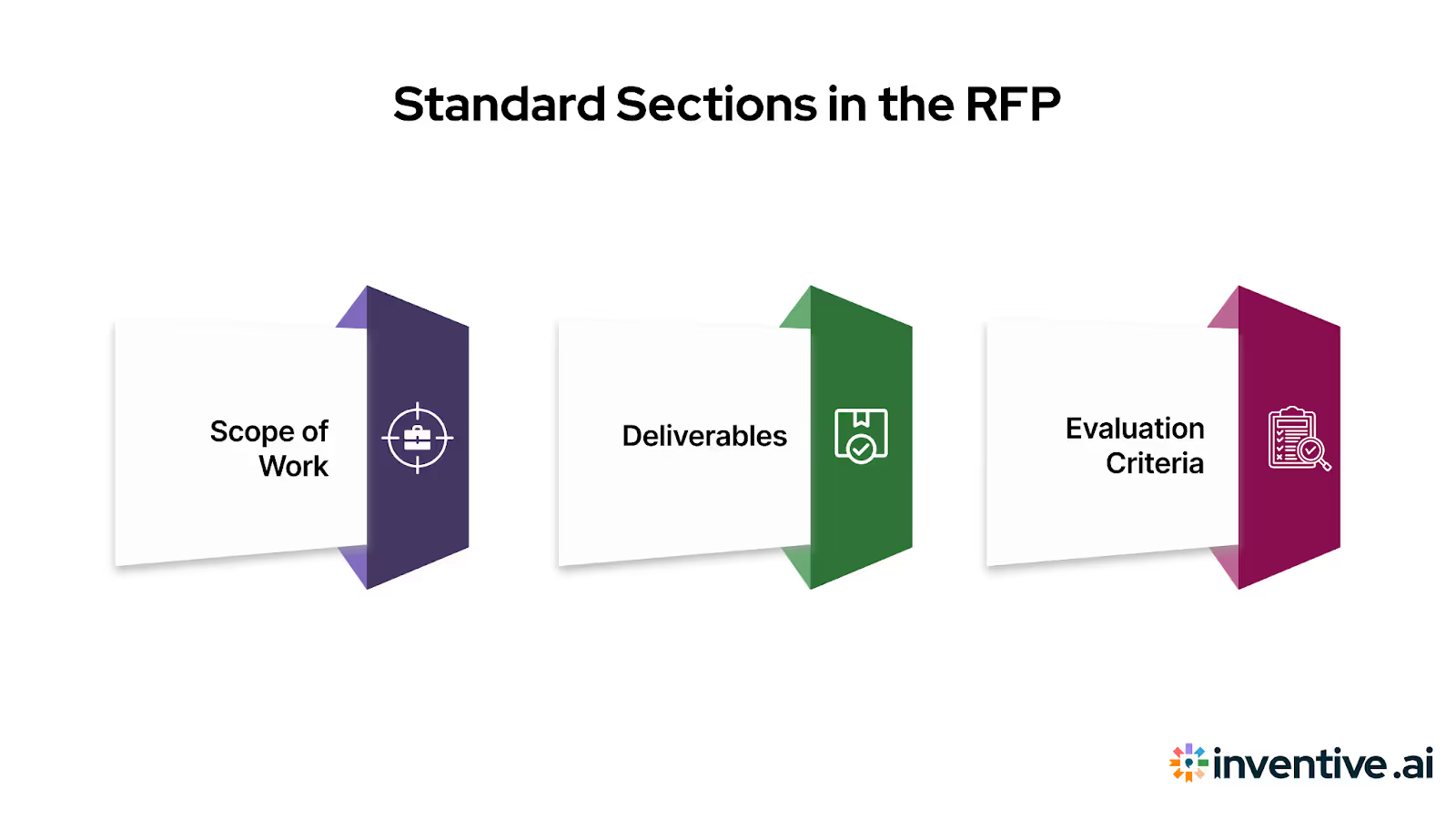
Government RFPs follow a structured format that helps agencies clearly communicate their needs and evaluate vendors fairly. Key sections usually include:
- Scope of Work
This section details the languages required (e.g., Spanish, Chinese, Vietnamese), volume estimates (number of pages or words), types of content (written materials, audio transcripts), and expected turnaround times. It may also specify requirements for certified translations or technical subject-matter expertise. - Deliverables
Vendors must understand what final products are expected. Deliverables often include fully translated documents formatted to match originals, glossaries of key terms, style guides, and quality assurance reports. This section sets standards for accuracy and consistency. - Evaluation Criteria
Agencies outline how proposals will be scored, typically considering:- Vendor qualifications and certifications (ISO, ATA)
- Past experience with similar projects, especially government contracts
- Translation and quality control workflows
- Ability to meet deadlines and manage project volume
- Pricing transparency and cost-effectiveness
This clear structure allows vendors to align their proposals with agency priorities, increasing the chances of a successful bid.
Examining a real RFP example highlights common mistakes vendors make when responding and how to avoid them.
Common Mistakes to Avoid When Responding to a Language Translation Services RFP
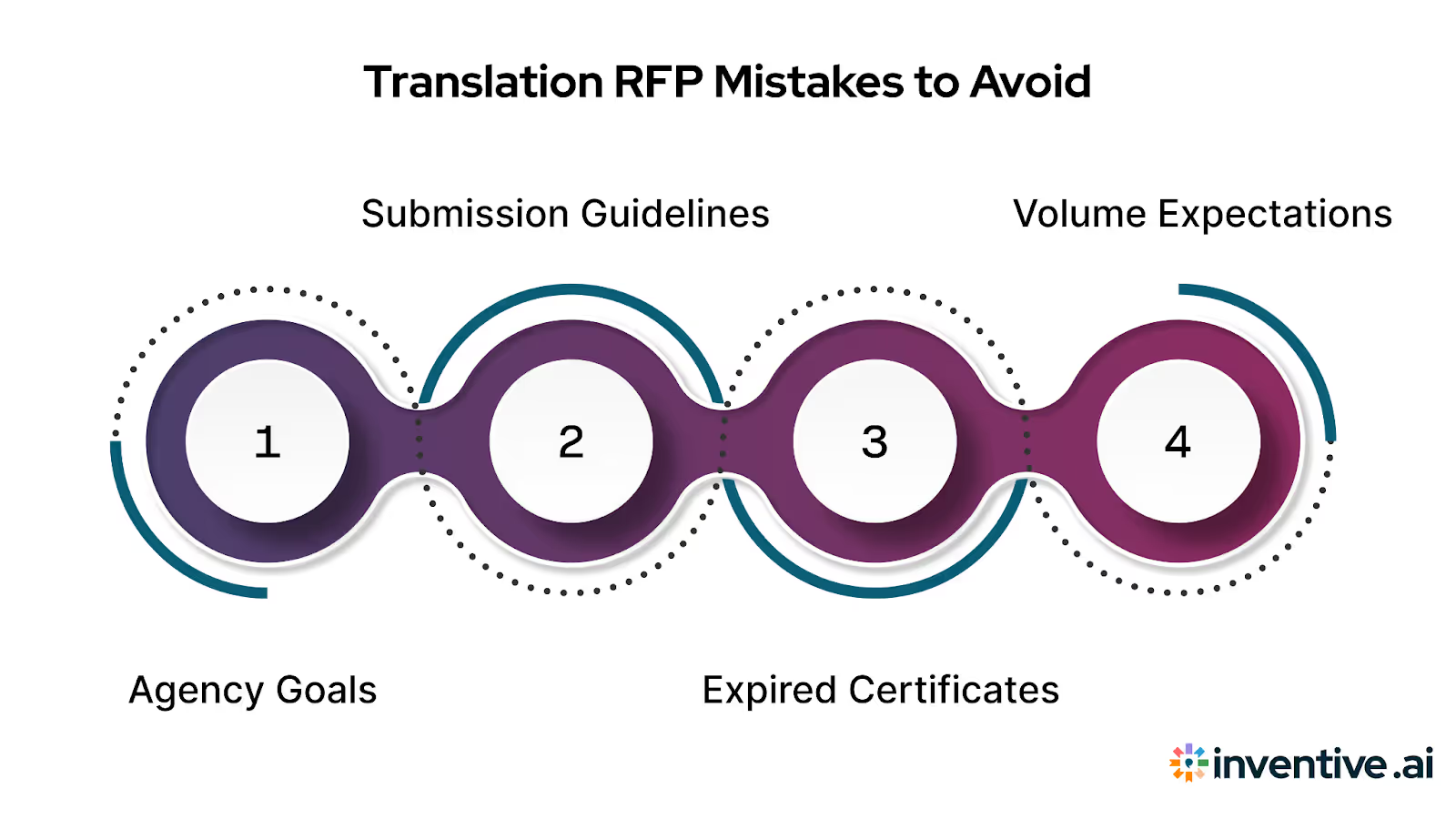
Responding to government RFPs requires precision and attention to detail. Small errors can disqualify a proposal or reduce its competitiveness. Understanding and avoiding common pitfalls improves your chances of winning contracts and speeds up the review process.
Here are frequent mistakes that undermine government bid responses:
- Reusing Generic Content Without Aligning to Agency Goals
Proposals that recycle boilerplate text without addressing specific agency priorities appear disconnected. Tailor your response to reflect the agency’s mission, project scope, and key requirements. - Missing Formatting or Submission Guidelines
Government RFPs often have strict rules on document format, page limits, and submission methods. Ignoring these leads to outright rejection, regardless of content quality. - Submitting Outdated Qualifications or Expired Certificates
Agencies require up-to-date certifications to verify vendor credibility. Including expired or irrelevant documents raises doubts about your compliance and professionalism. - Ignoring Mandatory Language Pairs or Volume Expectations
Failing to confirm that you can provide all required language combinations or meet volume demands signals inability to fulfill contract terms. Clearly confirm your capacity and expertise.
Avoiding these errors saves time for your proposal teams and improves your company’s reputation with government buyers. Accurate, compliant, and customized responses strengthen your bids and help your sales and proposal teams focus on value-driven content.
Avoiding these common pitfalls sets the stage for adopting best practices that increase your chances of winning government translation contracts.
Best Practices to Win Government Bids for Translation Services
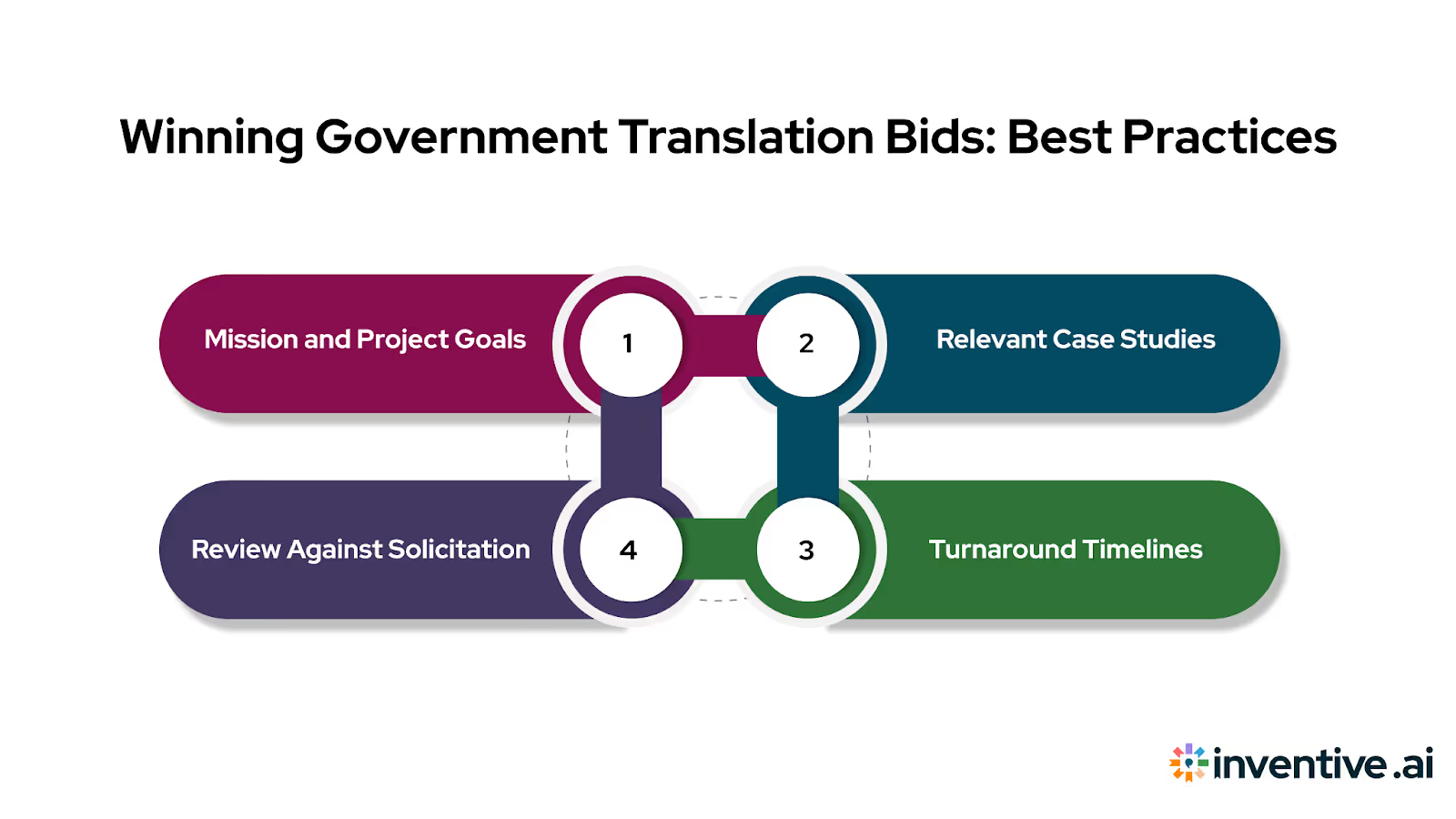
Winning government bids requires more than just meeting basic requirements. Proposals must demonstrate alignment with agency priorities, prove vendor credibility, and show attention to detail. Following these best practices helps sales and proposal teams improve efficiency and boost win rates.
Consider these essential tips to strengthen your RFP responses:
- Tailor Every Proposal to the Agency’s Mission and Project Goals
Customize your response to reflect the agency’s specific needs and objectives. Highlight how your translation services support their mission, whether it is public health communication, legal compliance, or community outreach. Generic responses reduce impact and lower your chances. - Use Updated Translator Credentials and Relevant Case Studies
Include current certifications such as ISO 17100 or ATA accreditation for translators. Add case studies showcasing similar projects, especially government contracts, with measurable results like on-time delivery and quality assurance outcomes. These build trust and credibility. - Provide Transparent Turnaround Timelines
Clearly specify your delivery schedules and ability to handle volume surges. Transparent timelines help agencies assess your capacity to meet deadlines, a key factor in awarding contracts. Avoid vague statements and back timelines with past performance data. - Review Against Solicitation Checklists Before Submission
Thoroughly check your proposal against the RFP’s submission guidelines and evaluation criteria. Confirm compliance with formatting, required documents, and mandatory language pairs. A final quality check reduces the risk of rejection for technical errors.
Following these practices helps align your proposals with government expectations, making your team more effective and increasing the likelihood of winning translation services contracts.
Also Read: How to Write an Effective RFP Response
Applying best practices is easier with tools like Inventive AI, which streamlines and strengthens your RFP response process.
How Inventive AI Helps Vendors Respond to Language Translation Services RFPs?
Responding to language translation services RFPs requires speed, accuracy, and seamless collaboration across multiple teams. Inventive AI addresses these pain points by automating time-consuming tasks and centralizing essential content, allowing vendors to focus on refining proposals that win contracts.
Key features that streamline and strengthen RFP responses include:
- AI-Generated First Drafts 10X Faster
Inventive AI rapidly creates initial drafts using your organization’s knowledge base, cutting down manual writing time and accelerating the entire response process. - Centralized Access to Past Responses and Translation Certifications
Store and organize previous RFP answers, translator credentials like ISO or ATA certifications, and related documents in one hub, making retrieval fast and reliable. - AI Content Manager Flags Outdated or Conflicting Entries
The system automatically identifies stale or inconsistent information, ensuring only accurate and up-to-date content is used in responses. - Smooth Collaboration Across Sales, Proposal, and Legal Teams
Integrated workflows enable multiple teams to work together efficiently, sharing updates and approvals without delays. - Cut Response Times by 90%
Automation reduces repetitive manual tasks, freeing your team to focus on strategic improvements and meeting tight deadlines. - Boost Proposal Accuracy to 95%
Consistent, validated content minimizes errors and aligns all responses with your company’s messaging and compliance needs. - Increase Win Rates by 50% with Stronger, More Consistent Messaging
Inventive AI’s tools help produce clear, targeted proposals that resonate with government buyers, improving your chances of contract award.
By leveraging these capabilities, Chief Revenue Officers, Vice Presidents of Sales, Proposal Managers, and their teams can transform their RFP response process, increasing efficiency and winning more government bids.
Also Read: RFP Response Best Practices: Proven Steps and Tips to Win More
To strengthen your RFP responses, combine AI solutions like Inventive AI with clear details on the technology buyers expect.
Essential Technology and Tools Buyers Look for in Translation Service Proposals
Buyers often expect vendors to clearly explain the technology and tools they use to deliver accurate and efficient translation services. Including these details shows your technical expertise and your commitment to quality and consistency across all projects. Here’s a closer look at key technologies and how they add value:
1. Translation Management Systems (TMS):
A TMS is software that helps coordinate and manage the entire translation process. For example, it tracks progress across multiple languages, assigns tasks automatically to translators and reviewers, and centralizes communication. This ensures projects stay on schedule and reduces errors caused by miscommunication. Imagine translating a city’s emergency alerts into ten languages. A TMS lets your team work simultaneously, avoid duplicated work, and quickly update translations if the source document changes.
2. CAT Tools (Computer-Assisted Translation):
CAT tools assist translators by breaking documents into smaller segments and suggesting previously approved translations for similar phrases. For instance, if your team translates legal contracts regularly, CAT tools help maintain consistent use of specific legal terms throughout every document. These tools also include features like automated quality checks that flag missing numbers or inconsistent terminology, improving both speed and accuracy.
3. Translation Memory (TM):
Translation Memory is a database that stores all approved translated sentences or phrases. When a similar sentence appears in a new project, the TM suggests the prior translation. This reduces translation time and cost by reusing content, and it ensures uniformity across multiple documents or updates. For example, when translating annual public health brochures, TM helps keep recurring messages consistent every year without redoing the entire text.
Conclusion
Winning language translation services RFPs requires clear, well-structured proposals that align closely with government requirements. To improve your success rate, focus on tailoring each response to the agency’s goals, maintaining up-to-date certifications, managing content efficiently, and meeting deadlines without errors. Automating these steps reduces manual work and ensures consistency across teams.
Inventive AI tackles these challenges by:
- Saving up to 90% of response time, allowing teams to focus on strategic priorities
- Achieving 95% accuracy by using up-to-date and consistent content
- Increasing win rates by 50% through stronger, well-aligned proposals
What Customers Say About Inventive AI:
These testimonials highlight how Inventive AI improves efficiency and proposal quality across sales, proposal, and revenue teams. For Chief Revenue Officers, Vice Presidents of Sales, and Proposal Managers, adopting this AI-powered solution means winning more government contracts with less manual effort.
FAQs
Q: What are the most important sections to include in a language translation services RFP response?
A: A well-structured response must include your organization’s background and relevant certifications, a clear scope of language coverage and subject expertise, detailed translation and quality assurance workflows, security and confidentiality protocols, past performance on similar government contracts, and a transparent cost breakdown. Including these sections ensures your proposal addresses all evaluation criteria and demonstrates your capability to meet project requirements.
Q: How can vendors ensure compliance with government translation service requirements in their RFP responses?
A: Vendors should closely follow federal guidelines such as Executive Order 13166, which mandates language access for limited English proficiency individuals. This involves demonstrating multilingual capabilities, providing evidence of certified translators, and adhering to security and data privacy standards. Compliance also means meeting formatting and submission guidelines precisely to avoid disqualification.
Q: Why is tailoring a translation services proposal to the specific government agency critical?
A: Each government agency has unique mission goals and project needs. Tailoring your proposal shows that you understand the agency’s priorities, which increases trust and relevance. Use agency-specific language, include case studies or examples relevant to their sector, and align your service delivery timelines and quality measures with their expectations to stand out.
Q: What common mistakes should vendors avoid in language translation services RFP submissions?
A: Avoid reusing generic content that does not address the specific agency’s goals, missing mandatory formatting or submission instructions, submitting expired or outdated certifications, and neglecting required language pairs or volume commitments. Such errors can lead to immediate disqualification or lower evaluation scores, regardless of your overall service quality.
Q: How can automation tools improve the efficiency of responding to language translation services RFPs?
A: Automation tools streamline proposal drafting by generating initial responses quickly using past content and relevant data, which reduces manual writing time. They also centralize document management, ensure content freshness by flagging outdated information, and enhance team collaboration to maintain consistency and accuracy, ultimately speeding up the response cycle and increasing win rates.

